



An interview with Annie Abrahams and Albertine Meunier by Cyril Thomas, French art historian and art critic, who posed his questions by mail separately to each artist.
How would you define yourself as an artist?
Albertine Meunier:
Will the first question be the most difficult one? To take a look at and to define oneself as an artist? Impossible. Others do this for me. The pronunciation of the words: “I am an artist,” seems too difficult. If I am, I am not solely. Because of my daily professional activity in the field of web innovation, because of my personal history, my career as an engineer in optoelectronics, as a researcher, as an Internet project manager, I juggle continuously from one status to the other. I feel like a web schizophrenic! At the same time, me and another. Albertine is there to show the borders. Albertine (alias Catherine Ramus), is my identity-plug, my artist identity. Catherine Ramus has the same body as Albertine, but only Albertine is an artist.
Annie Abrahams:
I do not feel the need nor the desire to define myself. I may be wrong.
In my video series I confirm Ami Barak answers the question Is what you see around you art?, with: Yes, because it’s done by an artist. This sentence pronounced by a contemporary art curator is revealing. Value is determined by both the claim of the artist and – do not forget that – by the power invested in art to defend it.
I am not only an artist, to some people I’m a poet, for others a video maker, a photographer, a performer and even a singer. I am also someone’s partner, an academic, a researcher, a teacher, as I am the daughter of, the aunt of, the friend of…
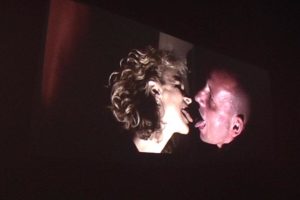
Would you say that you are Net-artists?
Albertine Meunier:
You add “Net” in front of a word and all of a sudden all becomes much simpler! If I am a net artist, my two “mes” are artists as well. Both of them handle, mix and play with the web. Me and my alter-ego, we try to understand the Internet, we digest it. We also try to protect ourselves from it. To be an artist of the Internet, a net artist, is to live the Internet as matter, to feel it breathing. In order to create, my two identities take detours, trace routes and analyse mechanisms in this universe.
Annie Abrahams:
Yes and no. No, because I refuse to qualify myself. I want to be both vague and fluid. I want to exist in different aspects and by following different roles and patterns. To some extent, I would like to remain an elusive identity. A moving person can be everywhere at the same time, is capable of acting according to circumstances and their own desires.
Yes, when I have to defend networked art. Then I transform into a missionary who travels to Paris, to small villages, who flies to other countries, in order to show that the Internet contains more than pornography and games to download.
Annie Abrahams, how do you define Albertine Meunier’s art practice? What are its main characteristics?
Annie Abrahams: Albertine Meunier = + or – Catherine Ramus. Albertine and Catherine have an intense practice on the Internet. They move around in the Internet with an enormous appetite coupled to an analytical eye and a strong willingness to show us, often through diversion, why and how the tools we use every day determine who we are, and sometimes take control over us.
In 2004, Albertine Meunier didn’t exist yet, only Cathbleue and Counter Googling existed. In this work Albertine published biographies meant to hijack and parasite the emergent practice called “googling” – i.e. the action of typing the name and surname of a person into the Google search engine – in order to create other identities, less truthful but far more humorous.
Since late 2006, with the work in progress My Google Search History, Albertine started publishing the history of her own Google searches. By making private data public, this work totally destroys the value of Google’s possession of personal data. Albertine points to the idea that the best way to react to the panoptical tendency of the Internet is to give and to share everything publicly, in order to make the race for personal data by private companies useless. Is it a way to immunise ourselves against attacks on our private space? Or a simple defence formula saying: “Take all my data, it is not me. You are mistaken if you think you can have me under control. I remain the one who decides, you cannot fool me” On one side it is delicious to see that a single person can intervene in the policy of a great Internet mastodon. On the other hand, this art piece draws a very intimate self-portrait of its author.
Catherine, Cathbleue, Albertine, three identities who raise essential questions that also underlie my own practice, “Who am I in a society where my references are located on the Internet? Who am I in a society with changing notions of identity and intimacy, turned upside down by networked practice? How will our identity evolve in the future? Where will it be hosted? In 1999, I asked three people to play Annie Abrahams in a networked performance entitled I only have my name. A few weeks after, I wasn’t able to recognise which of the four “Annies” in the performance was the real, authentic one. This experience strongly upset me. Play with and about identity is always disconcerting, maybe even dangerous, indeed, it generates real uncertainty.
Albertine Meunier, I address to you the same question in connection with the work of Annie Abrahams? More particularly, what does the metaphor of the “ant”[1] evoke?
Albertine Meunier:
In her pieces, there is an omnipresence of texts collected on the Internet and a constant presence of the voice. Words are repeated, sounds also. Repetition is fundamental in her creations; it is what involves us in familiar bodily sensations: fear, loneliness, the need to be reassured, separation…
In one of her works, Annie Abrahams says: “by repeating the content disappears”. The formal content disappears in order to allow the sensation, the feeling. The body with it’s emotions, it’s beats, it’s excesses, it’s irritations is made present…
The titles of her pieces reflect this bodily presence: Alone – Who am I? – I have only my name – Understanding – Tout va bien – Puisque ma voix / Since my voice – Do you doubt – One the puppet of the other – reassuring – Bitter times – Being Human – Separation – Painsong – Attentions – Solitudes – Breaking Solitudes – I am an artwork – Happy moving – Don’t touch me.
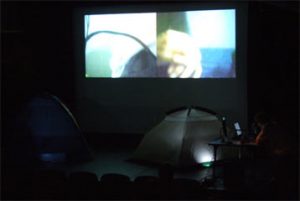
Annie Abrahams likes to assemble, to gather together. She says that she carries out “many collections on the Internet to observe the human being around her”.
On the occasion of a collective performance, she also brought together in a kind of Girls Band 11 French women working in and on the Internet. She constitutes a junction point between various people. This is concretely confirmed when she invites other artists to take part in the InstantS project or in the Breaking Solitude or Double Bind web performances.
The metaphor of the ant is directly related to her relational approach. The wandering ant, thanks to its “wanderings”, finds other sources, relates what was separate. Ants, with their way of approaching and touching each other, communicate and live together.
In her “collections”, Annie Abrahams evokes the idea “to give flesh and bone to what is on her screen,” because this “has lost its emotion.” In her pieces the emotion returns in the density of the texts and the voice. Through the omnipresence of the other in the work, of the relation with the other and of the barriers which are inevitably present, the limits of the skin emerge. And these reveal other borders, in particular those dealing with mutual comprehension.
When preparing this interview I also discovered a video I did not know: The green oaks. It’s a treat! One almost manages to feel the wind, present on the set on the afternoon when the film was made.
How did you come to work on and in the Internet?
Albertine Meunier:
Naturally and intuitively. With the arrival of the Internet, I quickly moved from the scientific sphere of optics towards the Internet. From white or black closed rooms[2], I passed into the world of open and unbounded Internet space. I engulfed myself in this unbounded universe where all seemed possible: to learn by one’s own methods, to construct, to communicate, etc. In parallel, I learned how to control the Internet in a professional framework. Very gradually, timidly, I began my artistic actions by publishing collages made up of texts and animated images. Year after year, I multiplied and enriched my practice by manipulating the Internet, the mobile phone, video formats… Today, I publish all my creations on the Internet. All is visible and downloadable online.
Annie Abrahams:
Since always, I have interrogated identity. Since always, I have sought my place in a world that I don’t understand. Since always, I have tried to comprehend the other. This is the very condition of my existence. It was impossible not to work on the Internet. Nowhere else, I can be closer to this other, nowhere else I can watch so intensely this other.
First I tried to better understand the world around me by studying biology at the University of Utrecht. (Doctorate, 1980) However, science did not help me to answer some very important questions. To quote Tolstoy: “What should we do and how should we live?” So, I radically changed my approach and went on to study at the Beaux-Arts. After my degree, I tried to identify what I called “truth” in installations based on 133 so-called chaos paintings. Then in 1990, I started using the computer. I quickly realised that besides efficient management of my installations in virtual and real space, this computer was also bringing other possibilities such as an escape from the gravity of the object.
In parallel, I increasingly began to work on the relation to the other, first in video, then also in installations. In 1995, in the gallery Ocre d’Art in Chateauroux, I created an installation called “Tribune / Refuge”. In 1996, I replaced all the tables of a bar in Nice – called the Wagram – with tables made out of paintings. In 1997, invited by an artists group in Nijmegen in the Netherlands, I developed an installation, a meeting device where the visitors could drink tea, eat cakes and assist in events. In order to be present from the South of France, I created my first website, quickly followed by the first works specifically designed for the Internet: Comprendre / Understanding,I am alone and I want a kiss, love and respect.
What place does the media occupy in your life and your practice?
Albertine Meunier:
I very much live the media through the web. The place of the Internet is central in my daily life because it is the place from which my ideas, my projects emerge. It’s like a small beating heart! The Internet is much more central than the newspaper deposited in the letter box, or the radio that I listen to in the morning. The newspapers and the radio function as appointments, which mark out the key moments of my day. They connect me with reality, with the thickness of matter. While the Internet is everywhere: everywhere in my day, everywhere in my eyes, everywhere in my practice, everywhere in my thoughts, and I cannot locate it anymore.
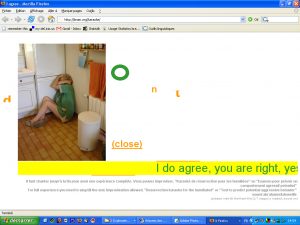
Annie Abrahams:
I almost always start my day by consulting my email account. Apart from my personal mail, I receive mail from SPECTRE, Nettime-fr, NetBehaviour, e-critures, NEW-MEDIA-CURATING, Empyre and a few other lists. I am also subscribed to some RSS feeds: “Instant RSS” from Nicolas Frespech, “Instants” of panoplie, Rhizome, Poptronics and some blogs of friends. Reading all these news, I easily spend two hours, in order to be informed and to keep in touch. Starting from information given by peers, I activate, I navigate and I operate the Internet. Some days I throw away everything except for my personal mail. This way I free myself from a ridiculous panoptic tendency. Then I relax, I am satisfied, because I managed to create empty time.
The Internet is omnipresent in my life, it determines my life, but by my actions I also control the Internet. I consider the Internet as a living organism with which I live on a day to day basis; either in a symbiotic relationship, where benefits are mutual, or in an almost parasitic way, that is to say beneficial to one and damaging or even harmful to the other.
You both record the modifications of the web, you note the evolutions. You evolve permanently with the tools placed at your disposal, you do not remain anchored on one type of software. The innovations related to the software, the new platforms become instruments which fit in your pallet.
Albertine Meunier:
I am interested in the evolutions of the Internet itself, and in particular in the tools, the services or the contents disposed of on the Internet; the service of Google Search History, the status of the friends of friends on Facebook, the mobile phone YouTube videos or the data of Freebase (free and open database accessible via an API[3]) which all become genuine matters for creation.
The Internet is unceasingly moving, has an incredible richness and is filled with innumerable contents. I wonder whether I do not seek to understand it, to capture it, to seize its nuances, its operations, its subtleties, its infinitude, its permanence. All in all, I try to touch the elusive.
Annie Abrahams:
In the beginning I was impressed by the possibilities of the Internet and I felt that each new tool could bring me new possibilities and that I needed to practice all of them in order to evaluate and judge them and eventually make art works out of them. Nowadays I focus more on the influences generated by such tools on our human behaviour.
Observing both your work, common topics appear: absence, disappearance, the trace and death… Do you think, the Internet abolishes temporality? Does it make a-temporal any physical trace, any inscription?
Albertine Meunier:
As a net artist, one knows that all this is very ambiguous. The Internet allows the storage of all, an eternal permanence and, at the same time, all can disappear in an eyelash, in a click. The Internet does not abolish all temporality, all physical traces or all inscriptions; it is at the same time impermanent and permanent. It is dubious. What will become of these pieces that only exist on the Internet? What will remain over time? It’s rather the law of all or nothing. A disappeared object, by a simple copy/paste operation, can reappear constantly because of its numerical nature. The Internet moves between two things: absence/presence – disappearance/appearance – traces/transparencies – inscriptions/obliterations. I think, the Internet transposes all on and in a binary mode. It transforms time, space, bodies and thoughts, in an operation between zero and one.
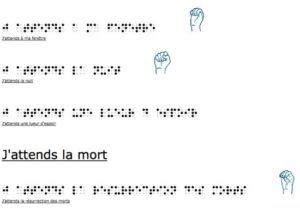
Annie Abrahams:
Being connected to the Internet may imply loosing the notion of your own body when you are online. It is comparable to the loss of a sense of time one might feel while writing a letter or while solving a puzzle. Our emotions are chemical states related to physical sensations. Emotions in their turn cause new bodily reactions. It is a biological cycle that begins at birth. The course of these cycles is inscribed unconsciously in our body. Sitting in front of my computer, my emotions are no longer associated with the same activity, with the same physical sensations as before. I type on a keyboard regardless of the emotion that crosses me. Whether joy, fear, disgust or anger, these emotions manifest themselves in the same way and so disturb my inner functions. I stress my body. My muscles tense. My level of excitement increases. Without necessarily noticing it, an unsteady state in my body settles down.
Albertine Meunier, what according to you are the interrogations conveyed by One the puppet of the other?
Albertine Meunier:
I did not see this performance live. I watched the video, with surely means a loss in perception. I was struck by the remoteness, the hesitation, and also by the silences – which do a lot of good – between the two characters. Somewhat like on the Internet, where a possible omnipresence of the other chokes, in these strained flux exchanges, silence is given a real breath.
The device of the performance itself is extremely disconcerting. Two tents inhabited by two persons connected by the Internet and communicating via webcam and microphone. First of all, these two tents resemble matrices, uterus; one wonders about the bond between them. The numerical umbilical cord, which connects these two people (these puppet-babies) directly one with the other, is also disturbing. Why are these “twins of the Internet” not together in the same space?
The title, One is [sic.] the Puppet of the other made me think of dislocated jumping jacks, stuck in a closed place, of directed puppets that wait until the wire coming from the Internet tells them what to do. By alteration, each one requires of the other to do or say something precise, for example: “Tell me your social security number” or “Face me…”.
In the beginning the one tells the other simply what to do and the other way around. Progressively during the performance, the symmetry in the device disappears, the puppets come to an independent life because each one is confronted with the other in its difference. So, they end up playing “dog and cat,” they say that they do not resemble each other much, and all of a sudden one is breathing.
How one and the other, do you invest the new social networks such as Myspace or Facebook?
Albertine Meunier:
I am not on Myspace. I am on Facebook. I am on Twitter. I am listening to Twitter’s chirping, where I am quite active, all day long. It allows me to have small news of my friends, of the web and of the “friends of the web.” My activity on Facebook is very minimal, I am almost only playing with “status.” I adore these short notes launched like numerical echoes on the Internet. Until now I particularly affection these short phrases of 140 characters. They became real matter for me. I adore reading those of others. This is probably at the base of my desire to make the Big Picture[4] and to use them in the Instants entre elle et lui, and in some of my videos.
They represent the assertion of oneself on these social networks and at the same time they are an almost useless gesture. The status of oneself or “statues of oneself” make us bathe in an ambient intimacy.
The Big Picture is an image of the updates of status on Facebook. Presented like a widget, the Big Picture consists of several zones, each zone being allocated to the status on Facebook of the friends of a person. The simple fact of moving the mouse on the surface of the Big Picture makes it possible to read the status on Facebook of a great number of people. This creation is also an artistic experiment in visualising the activity of a site like Facebook: to restore its rhythm, to make present the palpitations of its actors and also to record via videos[5] its accelerations, its decelerations, its stops. And last but not least: because any person can install, via a widget, all or a part of the Big Picture, the Facebook fortress is opened up a little bit.
For Instants entre elle et lui, I wrote every day and for approximately one month[6], poems with the Facebook status of people present in the Big Picture. The process was the following: Recover all the status present in the Big Picture on a particular day, make a selection of these statuses and finally create the instant, a poem, between her and him.
Extract of Instants entre elle et lui of April 17th 2008:
He crushes white.
He does nothing nothing nothing nothing nothing nothing nothing nothing nothing nothing nothing nothing nothing nothing nothing nothing nothing nothing nothing nothing nothing nothing nothing nothing nothing nothing nothing nothing nothing,
He is falling, it blows.
nothing discourages him!
she is high, low and below.
And she likes that.
by
Antoine Brea [Robin Hunzinger’s friend]
Xavier Leton [Andre Lozano’s friend]
JR Bellanger [Alex Andrek’s friend]
Andre Lozano [Albertine Meunier’s friend]
Laetitia To rust [Caroline Hazard’s friend]
Dawn Laloy [David Guez’s friend]
In these Instants of every day, I like to choose the status I prefer and give these a collective direction. This way I let some of their absurd but necessary content escape.
Annie Abrahams:
I watch closely how my “friends” are describing themselves on Facebook, how they establish links or not with others. I read their status, and look at their virtual libraries. Contrary to what one may think, people do not share much. They communicate their identities. It is usually more about promoting their tastes, their interests and expanding their influence.
Albertine Meunier, your observations nourish your works. How do these re-appear in your relation to the elderly people and your collective work the Big Picture?
Albertine Meunier:
With the Internet, I notice a certain impermanency, a ceaseless movement. One word replaces another and, at the same time, it can be stored at any moment, it can be fixed. The Internet is for me, quite simply, synonymous with life. Its movement is intrinsically associated with an accumulation…
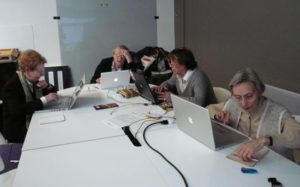
I noticed that with the Internet women that are more than 80 years old[7] have desires: desire to make, desire to say, desire to see, desire to listen, desire to show and to show themselves, desire to play with themselves and the other… Each day, these demonstrations of desire surprise me a bit more. All seems possible. Here, the wordplay: Internet makes us a life, has a sense. It makes a bit more immortal maybe.
Annie Abrahams, how do you analyse the Big Picture?
Annie Abrahams:
In the Big Picture, we see a nice colour table composed of a lot a coloured squares that shows in real time the Facebook Status updates of the “friends” of the Big Picture participants. Each status of a person is associated with a colour. According to the authors, Albertine, Olivier Auber and Yann Leguennec, this work is an artistic experience that should “capture the explosion of social media?” Be careful to the question mark and then imagine the follow-up: – People are more and more abandoning their Facebook activity, their status will no longer be updated and so they will disappear from the Big Picture table, leaving behind them the black square of death. On the contrary, Facebook might be booming and people will have more and more new “friends.” These new friends do not yet have colour, so their square is black but because newcomers are usually the most active, the table should also move towards a whole black picture, the dark colour of death.
According to you, what is the future of the Internet and the social networks?
Albertine Meunier:
Sacred question! The Internet is promised with a brilliant future… at the firmament of the media. I do not know how the social networks will change. They make more visible the contents inside groups, but it seems to me that their finite form has not yet been found. Their future will inevitably be determined according to what we are, we who have already changed so much in so little time.
For what concerns me personally, after ten years of practice I feel sometimes a little breathless running from link to link, a little mutant too. I become hypertext, hypermedia, hypernet. My spirit is “multi-task”, my brain “virtualised”, my body is sometimes elsewhere in the Internet, my thought is enriched but dispersed in all my roaming. I live in a kind of collective intimacy. The Internet grows, and I find out that my life narrows with the passing of days!
Annie Abrahams:
The future is in the hands of the users. It is through them that the Internet can grow, it is only by their “clicks” and “clacks” that one can earn money on the Internet. The users are also those who are building alternatives to proprietary softwares. They write blogs, create wikis and transform information sources. The Internet parasites these users, it feeds on them, it tries to phagocyte them by proposing behavioural molds such as Myspace or Facebook that make them harmless by encapsulating them. The Internet uses their loneliness, their need for recognition and fame.
I see all these users as living in their own bubble, in a sort of foam where everything is moving, where the exchange surfaces, in contact with other bubbles, are porous and let in some information but not other. Conglomerates form and disintegrate according to the requirements of the moment. It is not the image of an Internet where everything is connected by lines, but, I believe, the image of a fragile foam that reflects best our current situation. We should come out of our bubble to deal with the medium in which this foam will have to continue to exist. We should always leave our bubble.
This interview was originally undertaken for the French journal, Mercure, Les medias autrement, n.4-5.
Footnotes